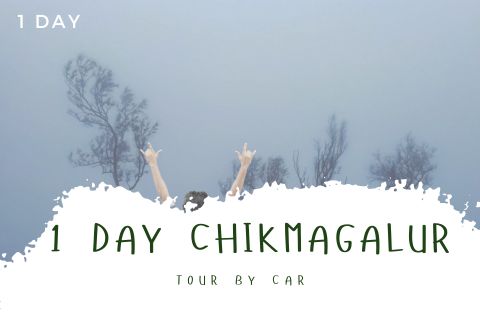Baba Budangiri Chikmagalur Entry Fee
- No Entry Fee
Baba Budangiri Chikmagalur Phone
N/A
Rating:  | 4/5 stars
| 4/5 stars
Based on total 54 reviews
Baba Budangiri Chikmagalur Address: Nagenahalli, Chikmagalur, Karnataka, 577131, India
Chikmagalur Tour Packages
Chikmagalur Tour PackagesBaba Budangiri Chikmagalur Timings
| Day | Timing |
|---|---|
| Monday | 8:00 am – 5:00 pm |
| Tuesday | 8:00 am – 5:00 pm |
| Wednesday | 8:00 am – 5:00 pm |
| Thursday | 8:00 am – 5:00 pm |
| Friday | 8:00 am – 5:00 pm |
| Saturday | 8:00 am – 5:00 pm |
| Sunday | 8:00 am – 5:00 pm |
Baba Budangiri is a mountain in the Western Ghats range in north of Chikmagalur district of the South Indian state of Karnataka. The mountain range of Baba Budan was also called Chandra Drona Parvat Shreni (Chandra Drona Mountain Range) during ancient times due to its natural crescent moon shape. It is also referred to as Dattagiri range by some people and is one of the prime tourist and trekking places in Karnataka.
At an altitude of 1895 meters, Baba Budangiri is the second highest peak in Karnataka whereas the other mountain peak in the same mountain range is Mullayanagiri which stands at an altitude of 1930 meters, making it the highest peak.
The Baba Budan Mountain is famous for the shrine of Sufi Saint, Baba Budan, who is worshiped by both Hindus and the Muslims and is a pilgrimage site for both. The mountain range is also famous among trekkers for its snake trails, moraine and rocky patches, grasslands, rolling hills, the blade ridges on the way to Mullayanagiri, camping grounds and cave explorations.
It is also a great photography destination for photography enthusiasts due to its rich indigenous flora and fauna, and the rare kurinji flowers blooming in the low-lying slopes of Nilgiris once in every 12 years.
Location of Baba Budangiri, Chikmagalur
Baba Budangiri hill is located 25 kilometers from Chikmagalur town towards north and around 270 kilometers from Bangalore and 110 kilometers from Mangalore.
History of Baba Budangiri, Chikmagalur
The shrine or dargah of Baba Budangiri is also referred to as ‘The Sri Guru Dattatreya Baba Budan Swamy Dargah’ and is equally revered by both Hindus and Muslims.
However, the origin of the syncretization of the reverence appears to have been for three separate saints, a 11th Century Sufi, Dada Hayath (real name being Abdul Azeez Macci), the 17th Century Sufi Baba Budan and Dattatreya, the paradigmatic monk and one of the lords of yoga, who is also considered to be the divine incarnation of the Hindu Trinity Brahma, Vishnu and Maheshwara.
If we go by the historical legends and beliefs, the 11th Century Sufi Saint named Dada Hayath, his real name being Abdul Azeez Macci, who was considered to be the direct disciple of the Prophet Muhammad, was sent to India from the Saudi Arabia to spread the message of Islam, in 1005 AD. His intention was to spread the message of peace and make people aware of the real tradition of sufism.
His religious preaching wasn’t meant to target the Hindu communities directly, but he wanted to preach the right way of life to the local landlords (also called palegars in local lingo) who were famous for their oppressiveness towards the underprivileged masses. However, this intervention by Dada Hayath did not go down well with the landlords and they tried to kill him.
Dattatreya, on the other hand is a Hindu God, believed to be the incarnation of the Holy Divine Trinity Brahma, Vishnu and Maheshwara (Shiva) and is considered to be the later phenomenon of Dada Hayath. This developed the syncretic culture among the devotees as they considered both saints to be interconnected and hence the synthesis of Shaivaite, Vaishnavite and Sufi cultures came together into being.
According to local beliefs, the Dattatreya tradition is a part of Awadhoot tradition that supports the worship of a one formless God and goes against casteism and rituals of animal sacrifice hence, the names Baba Budan and Dattatreya became interchangeable and both Dattatreya tradition and sufism go together.
Later, when Baba Budan, another Sufi Saint arrived in the hills and started meditating in the same cave as Dattatreya in the 17th Century, people believed him to be the incarnation of Dattatreya. Baba Budan selected the exact seat of Dattatreya for his meditation in the cave. His history can be traced back to Baghdad, who then travelled to Chikmagalur via Malabar and Mangalore. The devotees also refer to him as Syed Meran Baba and Jan-e-Pak Shaheed after he was killed in an ambush near the cave. He was buried inside the cave along with two other Sufis.
It was Baba Budan who introduced coffee to India. It is said that while returning from his pilgrimage to Mecca, Baba carried seven raw coffee beans and planted them on the hill and the first coffee is said to have been developed around 1670 AD on the Baba Budangiri hill.
Image Gallery of Baba Budangiri Chikmagalur
Baba Budangiri Temple - Dargah and Datta Peetha
Better known as the Inam Dattatreya Peetha, the shrine of Baba Budangiri is named after the famous Sufi Saint, Baba Budan. The saint is revered by people from all religions, especially both Hindus and Muslims thereby representing the unique syncretic culture where devotees from both religious beliefs offer their prayers in cave-like structure.
The grave or the shrine of Baba Budan is situated at the flat top of Baba Budangiri hilltop which can be reached by trekking all the way up. The caves of Dattatreya (Datta Peetha) are situated on top of the stairwell that rises from the dargah of Dada Hayath, the Sufi Saint, who is believed to be the direct disciple of the Prophet Muhammad himself.
The view of the Chikmagalur city from the shrine is something to behold. Do not miss spending some quality time here.
Baba Budangiri Trek
The trek to Baba Budangiri is a moderate level trek that spans a distance of 9 to 10 kilometers and can be completed in approximately 5 – 6 hours and can be completed in 2 phases. The best time for the trek is anytime between September to March as the weather remains mostly pleasant during the day. You may as well pitch your tents and camp here.
The base village of the trek is Attigundi and is flagged off at a point named ‘Sarpadhari’. This famous trek starts from the point behind Shiva Temple at Mullayanagiri peak, which is also the highest peak of Karnataka and ends in Baba Budangiri.
Phase 1: Mullayanagiri to Kavikal Gundi Checkpoint: This stretch of the trek is covered in grasslands and shola thickets and is a 3 kilometer stretch which can be easily completed as it has a defined trail with a properly marked pathway. This phase ends at Kavikal Gundi Checkpoint near Attagundi road. The trekkers need to receive permits to trek further from this point. The trekkers can relax for a while and have lunch or other refreshments and get their water bottles refilled here.
Phase 2: Kavikal Gundi Checkpoint to Baba Budangiri: While phase 1 is an easy and marked trail, the phase 2 trail can be confusing as it is lined with several narrow ridges that have steep valleys on one side and dense forest on the other side. There are occasional markings on rocks done by fellow trekkers for better direction; however, given the nature of the trail, there are chances of getting lost. The easiest way to get back on track or remain on the right trail is to follow the BSNL tower of Baba Budangiri.
This trail of the entire trek gives you a glimpse of the rich flora and fauna reserve that the hill is. There are around 250 different species of birds, a little over 300 herbs, several types of butterflies, orchids, flowers, timber, bamboo and much more.
Tips for Baba Budangiri Trek
There are eateries near Baba Budangiri hence you may not need to carry food. However, if you wish to cook, you may carry wood from the forest and set up your own barbeque.
It is highly recommended to be accompanied by a trek guide or a local for the trek for safety reasons.
The trek route is also mapped on Google.
If you wish to pitch tents for overnight camping, you may do that by the Manikyadhara waterfalls.
Entry Fee and Timings of Baba Budangiri, Chikmagalur
There is no entry fee to visit Baba Budangiri. You can visit it from 8 in the morning to 5 in the evening.
Best Time to visit Baba Budangiri, Chikmagalur
September to mid of February: This period between September to mid- February stays comparatively pleasant weather wise with cool but sunny days and the nights are usually cold where temperature drops to around 20 degrees, which makes it a perfect winter getaway.
March to April: This period is mostly warm and sunny bright days with few occasions of light pre- monsoon showers during the noon and sometimes during the day too. This is also the time for the famous Kurinji flowers, mountain flowers indigenous to the Western ghats, which bloom only once in 12 years in summer months. The last time these flowers bloomed was in 2018.
The monsoon months are not recommended for visit due to heavy and unpredictable rainfall. If you are visiting during the monsoon, you must be accompanied by a local guide as one tends to lose track of the trail in the woods.
How to Reach Baba Budangiri, Chikmagalur
You can reach Baba Budangiri from both Bangalore and Mangalore via roadway, railway and airway since it is well connected.
By Air: Located 110 kilometers from Chikmagalur, the Mangalore International Airport is the nearest airport to Baba Budangiri. You may hire taxis or prepaid cabs from Mangalore Airport to reach Chikmagalur. There are buses available too near the airport that would ply to and from Chikmagalur town.
The second nearest airport is Bangalore International Airport, which is 270 kilometers from Chikmagalur town. You may hop on to a private tourist bus which would directly take you to the Budangiri hill/shrine or you may also hire a cab from the airport to reach Baba Budangiri. The road trip from Bangalore to Baba Budangiri is approximately a 5-hour drive.
By Bus from Chikmagalur: Several private buses ply between Chikmagalur town and Baba Budangiri. These buses usually run on the Baba Budangiri Road or Thippanahalli Estate Road, scheduled every 3 hours, the first bus starting at 7:00 AM and the last bus leaving at 5:00 PM.
Shared Jeep for Baba Budangiri Trek: There are several trek groups that opt to reach Budangiri via shared jeeps from Chikmagalur. These jeeps usually leave from the Chikmagalur bus stand and drop the trekkers at Attigundi, which is the base village or starting point for the Budangiri trek.
By Cab: You can also book a private cab from top car rental companies in Chikmagalur to comfortably reach Baba Budangiri.
Get ready to experience the scenic beauty of Chikmagalur with the best available Chikmagalur Tour Packages . We at Chikmagalur Tourism, a division of Holidays DNA, specialize in designing customized tour packages based on your budgetary constraints. If you are looking for a tour package that covers topmost sightseeing places of Chikmagalur, then you can talk to our travel experts over the phone or book the same online. For any queries that may arise while booking, feel free to contact us through the dedicated Contact Us page.





